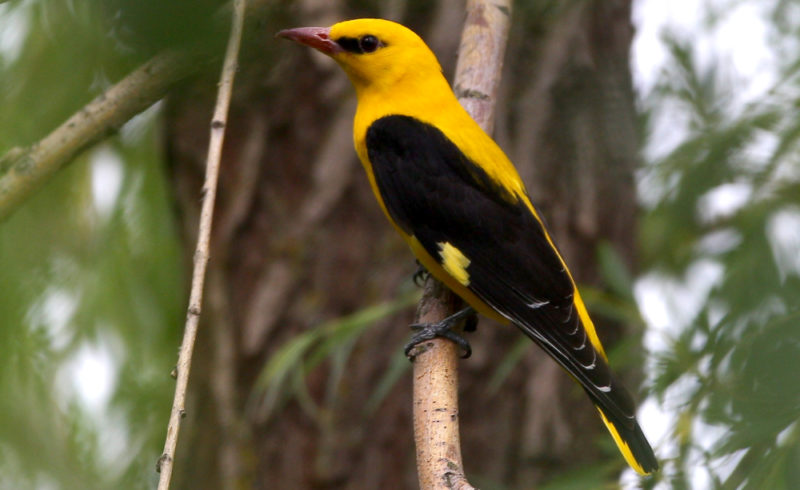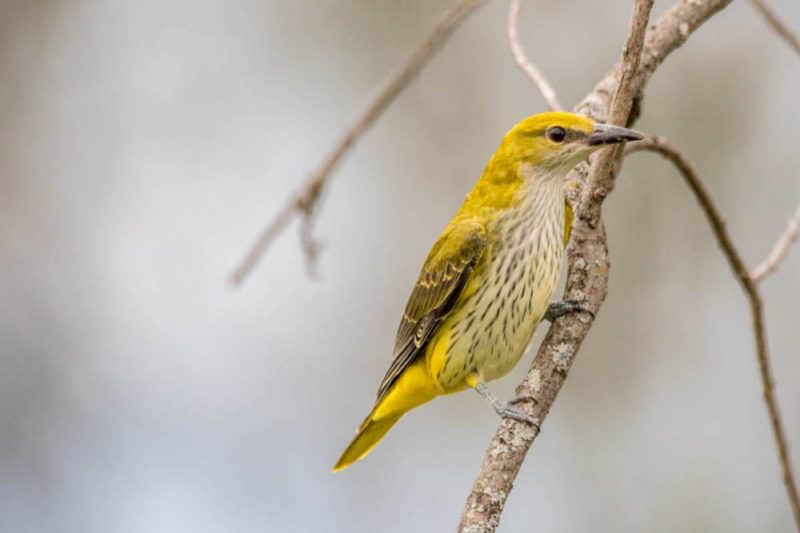The bird got its Latin name due to the bright yellow color of the plumage. The name of the genus and species epithet come from the word "aureolus", meaning "golden" in translation. European Oriole is found in Europe from May to September, and winter in the savannah and evergreen forests south of the Sahara.
Material Content:
Description and appearance of the bird
European Oriole is the only species of the Oriole family in Europe. Related species belonging to the same family of orioles nest south.
Type Description:
- A bright bird is larger than a starling with an elongated body.
- Length from 21 to 26 cm, wings 14–16 cm, weight 50–75 g.
- Plumage of a golden color (sexual dimorphism manifests itself in color).
- Bill is red or dark pink, long, strong.
- The iris is reddish.
The male is a yellow bird with black wings. The tail feathers are black with a wide yellow spot. On the head is clearly visible "bridle" - a dark strip from the beak to the eyes.
The female is greenish yellow. The upper body is brownish, the bottom is lighter, with a thin black hatching. Greenish-gray wings. When the female gets older, the color intensity increases. The plumage color of young birds is less bright than in adults.
Two subspecies of the Oriole common have differences in the length of the "bridle" on the head, the size and color of the feathers. One of them, the one that without continuing the black line behind the eye, is widespread in Europe, further east - in Western Siberia, in Asia - from the Caucasus to Altai. On the head of the second subspecies there is a black spot behind the eye.
Lifestyle and behavior
A moving bird usually rests in the crown of trees, quickly jumping from branch to branch. The Oriole flies in waves, developing a speed of up to 45 km / h.Bird without special needs does not appear in open spaces.
In the mating season, males attract the attention of a potential girlfriend with loud screams, jumping from branch to branch, “diving” in the air, “posing” with her tail spread. The female taking courtship answers with a whistle.
Habitat, habitat
Oriole is common in Europe, northwestern Africa. The range extends from France in the west to southern Siberia and China in the southeast. The northern boundary runs along 60–63 ° C. w. Autumn migration begins in August and ends in September. Birds feed in wintering places in October.
A subspecies from the European part of Eurasia is a migratory one. The birds winter in the savannahs of East and West Africa, making a path of 5–7 thousand km. The Orioles, on their journey, rest and eat on the vineyards and olive plantations of the Eastern Mediterranean, which is why they are considered pests in this region. Return to the nesting place from March to May.
The second subspecies lives in the south of Kazakhstan, in Central Asia, distributed to the western foothills of the Himalayan mountains, the lower Ganges. In India, birds are mostly nomadic, not migratory.
The common Oriole in the European part of the range lives in light broad-leaved and mixed forests, pine groves, forest belts. It is kept in floodplains, flies into settlements. Feathered usually avoids places without vegetation and dense dark forests. The bright bird in the settlements prefers large gardens with tall trees, parks, cemeteries, bushes.
The disappearance of natural floodplain vegetation, the use of pesticides has caused the greatest harm to the populations of beautiful birds in Europe. Threatened by the existence of the species deforestation of tropical forests, the use of pesticides in places of feeding, nesting and wintering.
In the Far East, the Chinese black-headed Oriole lives. Differs from ordinary black coloring of the upper part of the head, with a larger beak.
Oriole
The bird is omnivorous. The main food in the diet of the Oriole is small invertebrates: butterflies, dragonflies, mosquitoes, earwigs, beetles, some spiders. Birds themselves feed and feed offspring of adults and insect larvae, they extract livestock from cracks of tree bark with a sharp beak.
Orioles eat butterfly caterpillars, including hairy ones. Other birds do not touch them because of the poison in the hairs. Before feeding the caterpillar to the chicks, the Oriole kills the larva by hitting it several times on a tree.
A pair of Orioles needs a forage area of up to 25 ha.
Fruits of cherries, cherries, currants, grapes, mulberries in orchards, bird cherry berries, seeds in the forest are an addition to the diet of adults and young chicks. Orioles are less likely to eat small lizards, ruin nests of other species (redstart, gray flycatcher).
Breeding and offspring
The male arrives at the nesting place a few days earlier than the female, begins to sing, dares competitors from the occupied territory with his belligerent behavior, arranges fights. The mating season begins in May – June. During incubation of eggs, the spouse delivers food to the mother or replaces it in the nest during feeding, “entertains” with songs.
A pair of Orioles annually in May – June builds a deep cup-shaped nest, hanging it on the horizontal branches of tall trees closer to the edge of the crown. Birds weave the base of birch bark, bast fibers, grass stems up to 40 cm long. Inside, the dwelling is lined with soft plants, down, leaves, cobwebs, lichens, feathers. The “designer” and nest builder is a female, and her husband collects and brings material, scares off competitors.
The laying of the common Oriole consists of 3-5 eggs of white, pinkish or cream color with rare gray-brown or black spots. The incubation period lasts 15-18 days. Both parents feed the young, but the female is mainly involved in the upbringing. Often the chicks, when they leave the nest, are not yet fully ready for flight.Parents behave courageously in relation to predators, protect posterity.
Natural enemies
The Oriole shouts ravens, magpies, and jays from the nest with loud cries and in other ways. The bird behaves very belligerently in relation to other birds ravaging nests. Large birds of prey prey on adult orioles and chicks: the sparrow hawk, peregrine falcon, falcon, kestrel, eagles and kites.
Singing an Oriole
The bird's voice is strong, melodic, like a flute. The syllables “fiu-liu-li” differ. The repertoire is changing, interrupted. For example, in case of concern, the Oriole's voice becomes loud and hoarse. There is a cry of “yi-ikht” or “vi-ikht”, reminiscent of the scream of a frightened cat.
Interesting Facts
- It is believed that the Russian name of the bird appeared due to the love of the Oriole to water, moisture. In addition, male singing outside the breeding season portends rain.
- The Oriole usually hides in the crown of trees, so it is easier to hear than to see.
- The bird reaches puberty only in the second or third year of life.
- In a fight and chasing one after another, males develop speeds of up to 60–70 km / h.
- The oldest Oriole is 10 years and 1 month old. The bird was ringed in 1986 and was seen alive in 1996.
The experience of keeping the Orioles in captivity was described by a Russian amateur of birds, L.I. Kurguzov. The owner took the bird, who lived in a cage for 4 years, 1 km from the house and released it into the wild. After 1 hour, the Oriole returned to the cage left on the balcony of the house. The next time the captive was released at the other end of Moscow in the park. The most amazing thing is that she returned again, having overcome the path faster than the owner. When the bird was released for the third time, it did not return. Perhaps she was "offended" by her attitude ...
















